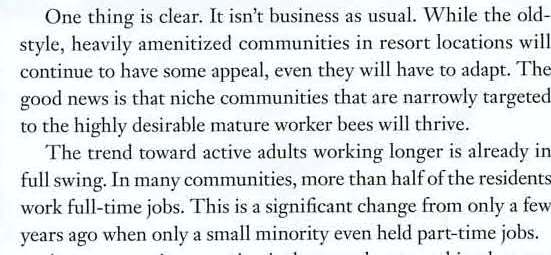Was 2009 the end of 55+, age-qualified, active adult housing? It certainly was a painful year for builders, developers, and experts like myself, who had expected this market would out-perform the overall housing market during a downturn. Instead, as I note in my Top Ten Take-Aways from IBS, mature homebuyers – primarily discretionary purchasers – exercised their discretion and stayed put.
Active Adult communities have been age-qualified; you must be 55 years old or better to live in one. For years, this type of housing has been a sweet spot.
However, the Baby Boomers were hit hardest of all by the crash of the financial, real estate and employment markets. Now, gone are a willingness to pay for golf course views or useless and expensive upgrades. Is the willingness to live in an age-qualified community gone, too?
Redefining Reetirement Communities
Even before our current economic challenges, Baby Boomers were already redefining retirement, and therefore redefining retirement communities. Tennis courts were being replaced by business centers. Bonus rooms were used as home offices. Research we conducted for Central Parke 55+ Resort Communities led to the establishment of an Osher Lifelong Learning Institute (OLLI) campus at their Victoria Falls community.
As I wrote for the 50+ Housing Magazine in 2007,
What’s next? At this year’s International Builders Show (IBS), industry experts told me the future was in:
- Urban infill
- Co-housing
- Aging-in-place
- University-affiliated senior housing
- Intergenerational communities
Everyone seemed to have a different opinion of where the industry would go. I think that they are all right, and I’m not even a politician. I say The Active Adult Market is Dead – Long Live the Active AdultS MarketS.
The Baby Boom is a generation of roughly 78 million. The US 50+ population is becoming increasingly diverse. One size of housing will not fit all; indeed, it never has.
For builders and developers, the challenge is to define which 50+ subgroup you’re targeting, and to take steps to truly understand them. Hire a good market research agency. Comb through your database. That prospect on your list is in a different place, economically and psychologically, than they were in 2008 or 2009. Conduct new surveys and listening sessions to understand what they now need and desire.
What do you think? What is the future of active adult housing? What can builders, developers and mature marketers do to thrive in a world with many different active adults marketS?




